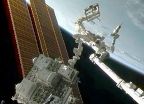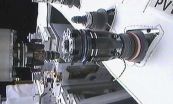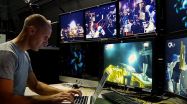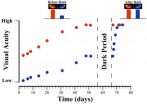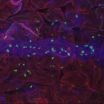GREENBELT, MD, February 15, 2013 (Press-News.org) Following six historic days of operations aboard the International Space Station, NASA's Robotic Refueling Mission, or RRM, demonstrated remotely controlled robots using current-day technology could refuel satellites not designed to be serviced.
RRM tests from January 14-25 culminated in a first-of-its-kind robotic fluid transfer, a demonstration that could be a catalyst to expanded robotic satellite-servicing capabilities and lead to a greener, more sustainable space. NASA also hopes that RRM technologies may help boost the commercial satellite-servicing industry.
"RRM gives NASA and the emerging commercial satellite servicing industry the confidence to robotically refuel, repair and maintain satellites in both near and distant orbits -- well beyond the reach of where humans can go today," said Frank Cepollina, associate director of the Satellite Servicing Capabilities Office, or SSCO at NASA's Goddard Space Flight Center in Greenbelt, Md.
New Technologies for a New Industry
Since 2009, SSCO has aggressively advanced robotic technologies for a notional, free-flying, servicer spacecraft that could access, repair and refuel satellites in geosynchronous Earth orbit, or GEO. RRM is a critical part of this technology development campaign.
"RRM allows us to take a major step into the future -- a future where humans and machines can together take on greatly expanded roles in space capability, research and exploration," Cepollina said.
Veterans of five manned servicing missions to NASA's Hubble Space Telescope, Cepollina and the SSCO team conceived the idea of RRM and saw it through its rapid 18-month development to its July 2011 launch on STS-135, the last space shuttle mission. A joint effort with the Canadian Space Agency, RRM uses the space station as test bed for the research and development of robotic satellite-servicing capabilities.
The cutting-edge technologies RRM demonstrates could extend the lives of many of the hundreds of satellites currently in GEO. These assets deliver such essential services as weather reports, cell phone communications, television broadcasts, government communications and air traffic management.
Servicing capabilities could greatly expand options for government and commercial fleet operators in the future, potentially delivering stakeholders significant savings in spacecraft replacement and launch costs.
RRM: A First-of-Its-Kind Refueling
The January RRM activities employed the teleoperated Canadian Dextre robot, four sophisticated RRM tools and the washing-machine-sized RRM module to execute an end-to-end refueling demonstration on orbit. Unlike other demos, RRM is the first to test the robotic refueling of satellite interfaces not designed to be accessed or serviced.
Robot controllers at NASA's Johnson Space Center in Houston first commanded an RRM tool -- working at the end of more than 70 feet (21.34 meters) of combined Dextre and Canadarm2 robotics -- to cut a pair of twisted wires each 0.02 inches in diameter, the thickness of four sheets of paper. Additional exacting tasks followed, with RRM tools cutting more wire -- used to secure satellite parts during launch -- and unscrewing and stowing two protective caps before finally exposing the representative fuel valve.
After the Johnson team threaded the RRM Nozzle tool with its attached hose onto the valve, operators at NASA's Marshall Space Flight Center in Huntsville, Ala., sent a precise sequence of commands to activate the RRM Fluid Transfer System. Liquid ethanol flowed from the Fluid Transfer System into the Nozzle Tool and through the attached fuel valve, ultimately pulsing back into the module's reservoir. Once the fluid transfer was complete, the Nozzle Tool used a novel technique to withdraw from the valve, leaving behind a clever "quick disconnect" fitting that would allow for a simpler and more efficient future refueling connection.
Future RRM tasks scheduled for 2013 include thermal blanket cutting, and fastener and electronic termination cap removals: all firsts of their kinds. A new round of servicing task boards, tools and activities are slated to continue its investigations through 2015.
Results Straight from Space
Results of RRM operations show that current-day robotic technology can refuel the common, triple-sealed satellite fuel valves of orbiting satellites. "The RRM tools, technologies and techniques passed their tests with flying colors," said SSCO deputy project manager Benjamin Reed. "We are immensely pleased with its success and very grateful to our partner the Canadian Space Agency."
The team's excitement in completing the task was heightened by the treasury of experience and insight gained from the exercise.
"Nothing compares to seeing how your hardware and procedures work in a real space environment," said Reed. "This is the beauty of being able to test new, game-changing technologies on the International Space Station."
"We were very excited to see the RRM refueling task validated the ground development work that our dedicated SSCO team performs every day," Reed said. "It is direct evidence that we are not working blindly in the proverbial vacuum, but rather that our carefully planned work at Goddard accurately simulates the real environment of space."
SSCO plans to present RRM results to date at the upcoming Satellite 2013 conference, as well as during space station panels and other events.
What's Next?
NASA continues to test capabilities for a new robotic servicing frontier. In conjunction with RRM, the SSCO team has been studying a conceptual servicing mission and building technologies to address uncharted territory. They include an autonomous rendezvous and capture system, a propellant transfer system for zero gravity and specialized algorithms to orchestrate and synchronize satellite-servicing operations.
On Jan. 15, NASA released a Request for Information to seek input on a potential public-private partnership to effect the full utilization of NASA-developed technology through an end-to-end technology demonstration of a satellite-servicing capability for client satellites located in GEO. The conceptual Restore Mission would potentially perform servicing operations in orbit in the 2018-2023 timeframe. RRM is proving the technology to achieve such a future mission.
"RRM is a harbinger of the next era in satellite fleet operations," Reed said. "It disrupts the accepted paradigm that a GEO satellite must be decommissioned at the end of its propellant reserves. Nearly 50 years of common practice is challenged with the options that RRM proves and foreshadows."
For more information on past, ongoing, and future ISS research activities, including research results and publications, visit:
http://www.nasa.gov/mission_pages/station/research/index.html
If you are interested in subscribing to updates from the ISS Program Science Office, visit:
https://lists.nasa.gov/mailman/listinfo/iss-program-science-group
For more information about the International Space Station, visit:
http://www.nasa.gov/station
NASA's Successful Robotic Refueling Demo Points To a Bright Satellite-Servicing Future
RELEASE: JR13-009
2013-02-15
ELSE PRESS RELEASES FROM THIS DATE:
RankTrader.com: A New Way to Invest in the Online Revolution
2013-02-15
Now, there's a new way to invest in an online business without having to own or operate your own website. By taking the old concept of a traditional stock market, RankTrader has created a new marketplace for the buying and selling of virtual shares or vShares, of a website.
Today we see many online entrepreneurs taking advantage of the ease of creating an online property and making money from advertising, internet marketing, e-commerce or even simply blogging. It's a rising trend and a new area to earn money. It may seem easy on the surface to make money online, but ...
Cure in sight for kissing bug's bite
2013-02-14
Chagas disease, a deadly tropical infection caused by the protozoan parasite Trypanosoma cruzi and transmitted by biting insects called "kissing bugs," has begun to spread around the world, including the U.S. Yet current treatment is toxic and limited to the acute stage.
In The Journal of Infectious Diseases (JID), Galina Lepesheva, Ph.D., and her colleagues at Vanderbilt University and Meharry Medical College report curing both the acute and chronic forms of the infection in mice with a small molecule, VNI.
VNI specifically inhibits a T. cruzi enzyme essential for ...
Cleveland Clinic develops clinical screening program for no.1 genetic cause of colon cancer
2013-02-14
Wednesday, February 13, 2013, Cleveland: Cleveland Clinic researchers have found that colorectal cancer outcomes could be improved with regular genetic screening for Lynch syndrome, the most common hereditary, adult-onset cause of colorectal cancer, as published in the online version of the Journal of Clinical Oncology.
Lynch syndrome is the most common genetic cause of colon cancer in adults. The study found that a universal screening program of all colorectal cancers surgically removed at Cleveland Clinic resulted in increased identification of Lynch syndrome patients ...
A little molecule's remarkable feat -- prolonging life
2013-02-14
NEW YORK, Feb. 14, 2013 – Nitric oxide, the versatile gas that helps increase blood flow, transmit nerve signals, and regulate immune function, appears to perform one more biological feat— prolonging the life of an organism and fortifying it against environmental stress, according to a new study.
The study reveals that a roundworm called Caenorhabditis elegans, an animal widely used in laboratory studies of aging, lives significantly longer when fed bacteria capable of manufacturing nitric oxide. The tantalizing observation points to one of the mechanisms by which the ...
Vision restored with total darkness
2013-02-14
Restoring vision might sometimes be as simple as turning out the lights. That's according to a study reported on February 14 in Current Biology, a Cell Press publication, in which researchers examined kittens with a visual impairment known as amblyopia before and after they spent 10 days in complete darkness.
Researchers Kevin Duffy and Donald Mitchell of Dalhousie University in Canada believe that exposure to darkness causes some parts of the visual system to revert to an early stage in development, when there is greater flexibility.
"There may be ways to increase ...
New study of the molecular roots of recurrent bladder infections could lead to a vaccine
2013-02-14
Urinary-tract infections are the second most common bacterial infection in humans, and many of them are recurrent. A study published by Cell Press on February 14th in the journal Immunity reveals the cellular and molecular basis of recurrent bladder infections and suggests possible treatment strategies, such as vaccines, to prevent this common problem.
"Our study shows for the first time that the bladder is unable to mount an effective immune response to bacteria, which could explain the high frequency of recurrent infections," says senior study author Soman Abraham ...
Roots of language in human and bird biology
2013-02-14
BOSTON, MA -- The genes activated for human speech are similar to the ones used by singing songbirds, new experiments suggest.
These results, which are not yet published, show that gene products produced for speech in the cortical and basal ganglia regions of the human brain correspond to similar molecules in the vocal communication areas of the brains of zebra finches and budgerigars. But these molecules aren't found in the brains of doves and quails -- vocal birds that do not learn their sounds.
"The results suggest that similar behavior and neural connectivity for ...
2 Cell studies reveal genetic variation driving human evolution
2013-02-14
VIDEO:
A pair of studies published by Cell Press on February 14th in the journal Cell sheds new light on genetic variation that may have played a key role in human...
Click here for more information.
A pair of studies published by Cell Press on February 14th in the journal Cell sheds new light on genetic variation that may have played a key role in human evolution. The study researchers used an animal model to study a gene variant that could have helped humans adapt to humid ...
Bilingual babies know their grammar by 7 months
2013-02-14
Babies as young as seven months can distinguish between, and begin to learn, two languages with vastly different grammatical structures, according to new research from the University of British Columbia and Université Paris Descartes.
Published today in the journal Nature Communications and presented at the 2013 Annual Meeting of the American Association for the Advancement of Science (AAAS) in Boston, the study shows that infants in bilingual environments use pitch and duration cues to discriminate between languages – such as English and Japanese – with opposite word ...
First animal model of recent human evolution
2013-02-14
The first animal model of recent human evolution reveals that a single mutation produced several traits common in East Asian peoples, from thicker hair to denser sweat glands, an international team of researchers reports.
The team, led by researchers from Harvard Medical School, Harvard University, the Broad Institute of MIT and Harvard, Massachusetts General Hospital, Fudan University and University College London, also modeled the spread of the gene mutation across Asia and North America, concluding that it most likely arose about 30,000 years ago in what is today ...
LAST 30 PRESS RELEASES:
University of Oklahoma researcher awarded funding to pursue AI-powered material design
Exploring how the visual system recovers following injury
Support for parents with infants at pediatric check-ups leads to better reading and math skills in elementary school
Kids’ behavioral health is a growing share of family health costs
Day & night: Cancer disrupts the brain’s natural rhythm
COVID-19 vaccination significantly reduces risk to pregnant women and baby
The role of vaccination in maternal and perinatal outcomes associated with COVID-19 in pregnancy
Mayo Clinic smartwatch system helps parents shorten and defuse children's severe tantrums early
Behavioral health spending spikes to 40% of all children’s health expenditures, nearly doubling in a decade
Digital cognitive behavioral treatment for generalized anxiety disorder
Expenditures for pediatric behavioral health care over time and estimated family financial burden
Air conditioning in nursing homes and mortality during extreme heat
The Alps to lose a record number of glaciers in the next decade
What makes a good proton conductor?
New science reporting guide published for journalists in Bulgaria
New international study reveals major survival gaps among children with cancer
New science reporting guide published for journalists in Turkey
Scientists develop a smarter mRNA therapy that knows which cells to target
Neuroanatomy-informed brain–machine hybrid intelligence for robust acoustic target detection
Eight SwRI hydrogen projects funded by ENERGYWERX
The Lundquist Institute and its start-up company Vitalex Biosciences Announces Strategic Advancement of Second-Generation fungal Vaccine VXV-01 through Phase 1 Trials under $40 Million Competitive Con
Fine particles in pollution are associated with early signs of autoimmune disease
Review article | Towards a Global Ground-Based Earth Observatory (GGBEO): Leveraging existing systems and networks
Penn and UMich create world’s smallest programmable, autonomous robots
Cleveland researchers launch first major study to address ‘hidden performance killer’ in athletes
To connect across politics, try saying what you oppose
Modulating key interaction prevents virus from entering cells
Project explores barriers to NHS career progression facing international medical graduates
Jeonbuk National University researchers explore the impact of different seasonings on the flavor perception of Doenjang soup
Two Keck Medicine of USC Hospitals named Leapfrog Top Teaching Hospitals
[Press-News.org] NASA's Successful Robotic Refueling Demo Points To a Bright Satellite-Servicing FutureRELEASE: JR13-009
